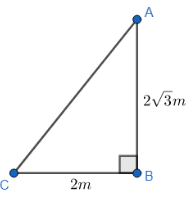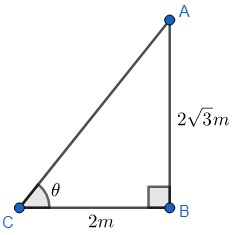
If the height of a pole is $2\sqrt{3}$ metres and the length of its shadow is $2$ metres, find the angle of elevation of the sun.


Answer
509.7k+ views
Hint: We know that the tangent of any angle is defined as $\tan \theta =\dfrac{\text{Perpendicular}}{\text{Base}}$. So, if $\angle BCA=\theta $, then we can write $\tan \theta =\dfrac{AB}{BC}$. Hence by putting the values of AB and BC, and using the fact that $\tan \theta =\sqrt{3}$, we can easily find the angle of elevation of the sun.
Complete step by step solution:
In the question, we are given that height of pole, AB = $2\sqrt{3}$ metres,
and the length of its shadow, CB = 2 metres.
It is clear that the pole AB is standing vertically at the point B, on the surface of the ground. We also know that CB is the shadow of the pole AB, with point C being the shadow of point A.
So, we can say that $\angle BCA$ is the angle of elevation of the sun.
Let us assume $\angle BCA=\theta $.

We can see that the triangle ABC is a right angled triangle, and thus we can use the trigonometric identities.
We know that the value of tangent of an angle is the ratio of perpendicular and the base. Mathematically, $\tan \theta =\dfrac{\text{Perpendicular}}{\text{Base}}$.
So, in triangle ABC, we can write $\tan \theta =\dfrac{AB}{BC}$.
Let us now substitute the values of AB and BC in the above equation. We get
$\tan \theta =\dfrac{2\sqrt{3}}{2}$
On simplification, we can write $\tan \theta =\sqrt{3}$.
Thus, we get
$\theta ={{\tan }^{-1}}\sqrt{3}$
Hence, we get that $\theta ={{60}^{\circ }}$.
Thus, the angle of elevation of the sun is ${{60}^{\circ }}$.
Note:
We must note that the value of ${{\tan }^{-1}}\sqrt{3}$ can either be ${{60}^{\circ }}$ or ${{240}^{\circ }}$. But, we know that any internal angle of a triangle can never be equal to ${{240}^{\circ }}$, because the sum of all internal angles is ${{180}^{\circ }}$. Thus, we can neglect the value ${{240}^{\circ }}$.
Complete step by step solution:
In the question, we are given that height of pole, AB = $2\sqrt{3}$ metres,
and the length of its shadow, CB = 2 metres.
It is clear that the pole AB is standing vertically at the point B, on the surface of the ground. We also know that CB is the shadow of the pole AB, with point C being the shadow of point A.
So, we can say that $\angle BCA$ is the angle of elevation of the sun.
Let us assume $\angle BCA=\theta $.

We can see that the triangle ABC is a right angled triangle, and thus we can use the trigonometric identities.
We know that the value of tangent of an angle is the ratio of perpendicular and the base. Mathematically, $\tan \theta =\dfrac{\text{Perpendicular}}{\text{Base}}$.
So, in triangle ABC, we can write $\tan \theta =\dfrac{AB}{BC}$.
Let us now substitute the values of AB and BC in the above equation. We get
$\tan \theta =\dfrac{2\sqrt{3}}{2}$
On simplification, we can write $\tan \theta =\sqrt{3}$.
Thus, we get
$\theta ={{\tan }^{-1}}\sqrt{3}$
Hence, we get that $\theta ={{60}^{\circ }}$.
Thus, the angle of elevation of the sun is ${{60}^{\circ }}$.
Note:
We must note that the value of ${{\tan }^{-1}}\sqrt{3}$ can either be ${{60}^{\circ }}$ or ${{240}^{\circ }}$. But, we know that any internal angle of a triangle can never be equal to ${{240}^{\circ }}$, because the sum of all internal angles is ${{180}^{\circ }}$. Thus, we can neglect the value ${{240}^{\circ }}$.
Recently Updated Pages
Why are manures considered better than fertilizers class 11 biology CBSE

Find the coordinates of the midpoint of the line segment class 11 maths CBSE

Distinguish between static friction limiting friction class 11 physics CBSE

The Chairman of the constituent Assembly was A Jawaharlal class 11 social science CBSE

The first National Commission on Labour NCL submitted class 11 social science CBSE

Number of all subshell of n + l 7 is A 4 B 5 C 6 D class 11 chemistry CBSE

Trending doubts
What is meant by exothermic and endothermic reactions class 11 chemistry CBSE

10 examples of friction in our daily life

One Metric ton is equal to kg A 10000 B 1000 C 100 class 11 physics CBSE

1 Quintal is equal to a 110 kg b 10 kg c 100kg d 1000 class 11 physics CBSE

Difference Between Prokaryotic Cells and Eukaryotic Cells

What are Quantum numbers Explain the quantum number class 11 chemistry CBSE




